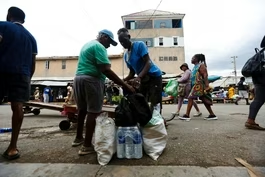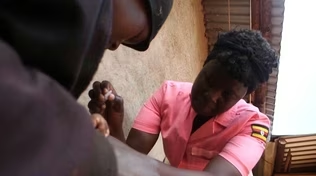
Experimental treatment offers hope to chronic pain patients
Clip: 10/25/2025 | 7m 1sVideo has Closed Captions
Experimental treatment offers hope to people struggling with chronic pain
More than 50 million Americans suffer from chronic pain, according to the CDC. Persistent pain that lasts beyond a typical recovery period can be debilitating and finding the right treatment is a challenge, but a recent study could provide a glimmer of hope. Ali Rogin speaks with New York Times health and science reporter Pam Belluck to learn more.
Problems playing video? | Closed Captioning Feedback
Problems playing video? | Closed Captioning Feedback
Major corporate funding for the PBS News Hour is provided by BDO, BNSF, Consumer Cellular, American Cruise Lines, and Raymond James. Funding for the PBS NewsHour Weekend is provided by...

Experimental treatment offers hope to chronic pain patients
Clip: 10/25/2025 | 7m 1sVideo has Closed Captions
More than 50 million Americans suffer from chronic pain, according to the CDC. Persistent pain that lasts beyond a typical recovery period can be debilitating and finding the right treatment is a challenge, but a recent study could provide a glimmer of hope. Ali Rogin speaks with New York Times health and science reporter Pam Belluck to learn more.
Problems playing video? | Closed Captioning Feedback
How to Watch PBS News Hour
PBS News Hour is available to stream on pbs.org and the free PBS App, available on iPhone, Apple TV, Android TV, Android smartphones, Amazon Fire TV, Amazon Fire Tablet, Roku, Samsung Smart TV, and Vizio.
Providing Support for PBS.org
Learn Moreabout PBS online sponsorshipNICK SCHIFRIN: The CDC says chronic pain affects more than 50 million Americans.
Persistent pain that lasts beyond a typical recovery period can be debilitating.
And finding the right treatment is a challenge.
But now a recent study could provide a glimmer of hope.
Ali Rogin recently spoke with Pam Belluck, health and science reporter for the New York Times.
ALI ROGIN: Pam Belluck, thank you so much for joining us.
Before we jump in, I'd like to play a collection of interviews we did with people living in chronic pain from across the country.
JOANNA BLACKHEART: It ranges from things as being as simple as, you know, having something like back pain that you may experience on a daily basis, to literally not being able to get out of bed to be able to brush your teeth.
ANDREW GOETZE: The simple act of driving to work makes the commute extremely painful.
REBECCA LUCIER: I start my mornings, you know, assessing which joint needs to kind of be put back in place, and then my day goes from there.
MEG MINDLIN: Even today, like, I've had a 7 out of 10 migraine all day today.
I still got up, I still did my errands.
And it's something that people living in chronic pain are just forced to do.
ANDREW GOETZE: I have had to cancel outings on weekends, local trips around the area, just for the simple fact of waking up and rolling out of bed and realizing that day was just going to be Tylenol and couch and ice and heat and hope for the best.
REBECCA LUCIER: I look totally fine, but I'm dealing with an invisible illness, and that's very frustrating because I'm in a lot of pain.
But I mask it.
JOANA BLACKHEART: You know, you might see someone suffering in public, and they could very easily be hiding it because they just have to.
But also sometimes it's not possible to do that.
It's a unique kind of torture.
ANDREW GOETZE: The sort of guilt and shame, at least I feel of questioning, you know, could I have avoided some of these injuries or was I just the built to be broken.
REBECCA LUCIER: I was very active.
I was a swimmer, I rode my bike, I played sports.
And now I can't do any of those things.
And it took a long time for me to mourn that loss and accept what my new life was, especially at my younger age.
MEG MINDLIN: It was very difficult to experience chronic pain as a child, and I didn't really understand what it was that was going on.
I just knew that I was in pain all the time and that I didn't feel good and nobody would believe me that I didn't feel good.
And it led to a lot of really bad mental health problems because I just wanted the pain to stop.
ALI ROGIN: Some of that is really hard to hear.
You've been speaking to people who suffer every day.
Why is chronic pain so difficult to treat?
PAM BELLUCK, The New York Times: Yeah, those were really moving.
And I've heard, you know, many people expressing similar things.
It can just be really debilitating for people.
It's hard to treat because it has a tremendous amount of variation.
It's very individualized, lots of different causes.
There's not kind of a single point in the brain or even in the body for many people that can actually be treated.
There's no kind of center of pain.
So, you know, a lot of the medications that we have don't work for everybody.
The other methods that we have, like spinal cord stimulators or nerve blocks, they help some people, but they just don't work for everybody.
ALI ROGIN: So you looked at a trial that was done.
It was a very small trial, but potentially groundbreaking.
What did you learn about it?
PAM BELLUCK: Yeah, this was a clinical trial that was looking at an approach called deep brain stimulation.
And what deep brain stimulation is, it involves implanting electrodes in the brain and using those electrodes to deliver pulses of electrical stimulation.
What these researchers that I was following did is they said, you know, let's see if we can try it in a different way.
Usually, deep brain stimulation involves putting the electrodes in one area or maybe two areas in the brain and then turning on the stimulation and just kind of setting it and forgetting it, and so it's on continuously.
But these researchers, their idea was maybe that doesn't work for people with chronic pain because there isn't one or two specific locations in the brain that are going to work for everybody.
And maybe if we have it on all the time, the brain adapts to it, and then it just sort of stops working for people.
So what they did is they spent a lot of time trying to identify in a small number of patients, the specific brain locations that would respond to their pain when their pain was at its worst.
They created these algorithms using AI, and then they implanted the electrodes in those locations.
And so it kind of operated like a thermostat for the brain, where it was responding to the patient's pain signals, giving that burst of stimulation, turning it off, and then the next time they were in pain, it would do the same thing.
ALI ROGIN: What did the experts you spoke to say about the potential for broader application of this particular therapy?
PAM BELLUCK: So I think that's a really, you know, open question.
This technique itself, obviously right now is invasive.
It's expensive.
So in the form that it is in right now, and of course it's not yet approved, it would be hard to scale it up to help a whole lot of people.
But as one of the researchers I talked to said, if you think of this like a pacemaker for the brain, which is what this technology is often referred to, pacemakers for the heart decades ago were also very expensive and invasive and people didn't know how widely they could be used.
So, I think that as we learn more and as the technology becomes more accessible, there is potential for it to be used for more patients.
The other kind of crucial thing, though, is that studies like this, particularly where they're trying to look at individual hallmarks and markers of pain in the brain, they can teach scientists a lot about how pain works and that can lead to other kind of less invasive, less expensive methods of treatment.
You know, part of this is to really help scientists understand this very complex and individualized condition.
ALI ROGIN: Pam Belluck with the New York Times.
Fascinating reporting.
Thank you so much.
PAM BELLUCK: Thank you.
China launches largest crackdown on Christians in years
Video has Closed Captions
Clip: 10/25/2025 | 7m 13s | China’s Xi launches largest crackdown on country’s Christians in years (7m 13s)
News Wrap: Melissa becomes a hurricane in the Caribbean
Video has Closed Captions
Clip: 10/25/2025 | 2m 35s | News Wrap: Rapidly intensifying Melissa becomes a hurricane in the Caribbean (2m 35s)
Nurse in Uganda climbs a 1,000-foot ladder to save lives
Video has Closed Captions
Clip: 10/25/2025 | 1m 44s | Meet the nurse in Uganda who climbs a 1,000-foot ladder to save lives (1m 44s)
U.N. agencies rush aid into Gaza as Trump heads to Asia
Video has Closed Captions
Clip: 10/25/2025 | 5m 9s | U.N. agencies rush aid into Gaza as Trump starts Asia diplomacy tour (5m 9s)
Providing Support for PBS.org
Learn Moreabout PBS online sponsorship
- News and Public Affairs

FRONTLINE is investigative journalism that questions, explains and changes our world.

- News and Public Affairs

BREAKING the DEADLOCK sparks bold, civil debate on America’s toughest issues.












Support for PBS provided by:
Major corporate funding for the PBS News Hour is provided by BDO, BNSF, Consumer Cellular, American Cruise Lines, and Raymond James. Funding for the PBS NewsHour Weekend is provided by...



